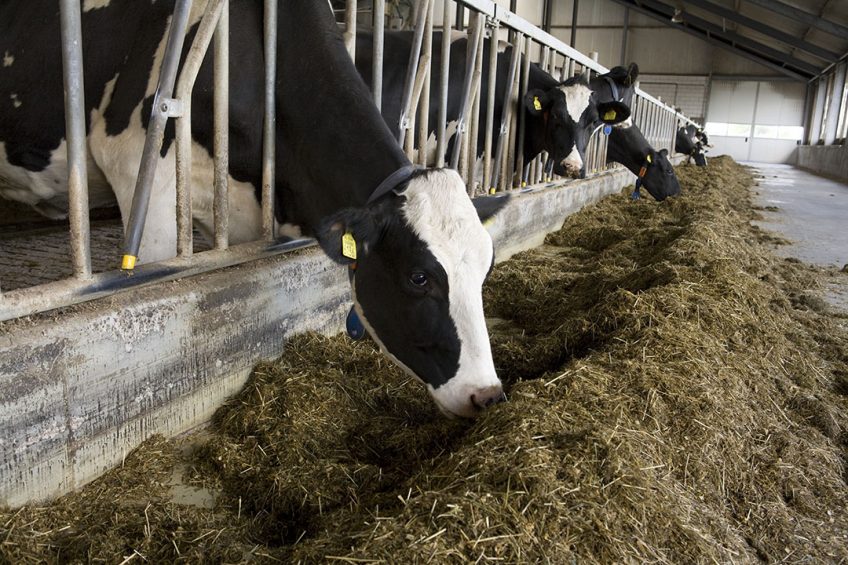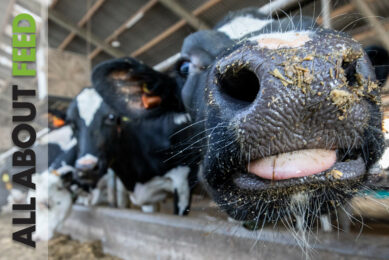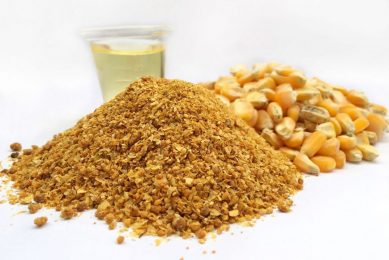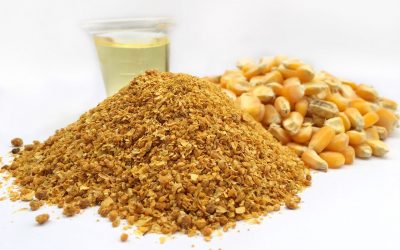Distillers’ grains for ruminants: Assessing protein quality

The protein the cow receives comes from 2 origins: feed protein and microbial protein. Depending on its degradability, part of the feed protein is broken down in the rumen (RDP) by specific microorganisms which will use its nitrogen (and sometimes other elements), carbon chains, hydrogen, oxygen, and energy to produce their own protein.
The passage of digesta from the pre-stomachs to the intestine will carry this protein (MP) as constituent of microbial cells to be digested in the intestine. The protein that is not degradable (RUP) in the rumen will pass intact to the intestine to also be digested there. There is usually a small fraction (heat damaged protein) that cannot be digested and will go through the digested tract intact, ending up in the manure.
Rumen undegradable protein
We need to think of protein in terms of 2 macro pools, the rumen population, and the host. Let us concentrate on the importance of the protein that escapes the rumen and is digested in the intestine of the cow. We often call this protein bypass protein or rumen undegradable protein (RUP).
For proteins to be degraded by microorganisms or animal enzymes they must be in aqueous solution. It is therefore easy to understand why protein solubility is associated with degradability. Some feeds have more RUP because of their inherent structure which makes them relatively insoluble. An example is prolamin protein (zein) in corn grain which has lower degradability in the rumen because of its hydrophobicity. Other instances of inherent reduced degradability are polyphenolic polymers such as tannins, which inhibit enzymes lowering the rate of protein degradation and deamination in the rumen. Other factors are for example the heat treatment of the protein, either unintentional (heating during preservation) or intentional during drying, which leads to a chemical reaction between amino acids and reducing sugars (Maillard reaction), which renders both nutrients unavailable for digestion. Let us focus on heating since it has been widely adopted by the feed industry as a method to protect plant protein from rumen degradation.
When heating is too much
When feedstuffs are heated in the presence of moisture, at a high enough temperature, and during enough time, a reaction occurs called the Maillard reaction (M. Maillard. 1925). In simplified terms, the reaction begins when the amino group of one amino acid (frequently lysine) reacts with the carbonyl group of a reducing carbohydrate forming a glucosamine. Not only sugars can be tied in the Maillard reaction but also hemicellulose, thus further reducing the availability of other highly digestible carbohydrates in ruminants and other livestock species. The glucosamine then undergoes what is called an ‘Amadori rearrangement’, which chemically consists of the conversion of the N-glucosamine to the corresponding keto-amine. The keto-amine then forms melanoidins and other brown nitrogenous polymers which impart the characteristic brown colour to heat damaged feedstuffs. The end-result are compounds that cannot be digested, and thus reduce the protein, carbohydrate, and energy supply to the animal. The initial stage in this chain of events though (glucosamine production) is reversible, becoming irreversible once the reaction progresses beyond the keto-amine conversion. The challenge for the animal feed industry then is to determine the point where protein is less degradable (initial stages of the reaction) in the rumen but still digested in the intestine.
Distillers’ dried grains (DDG)
It is well known that DDG are a good source of RUP. Since the degradability of corn protein is roughly 50%, any undegradable crude protein (CP) above that value will usually be the result of heating during processing. It is important to determine how much of this protein is still available from a nutritional standpoint. The detergent system of analysis measures neutral detergent fibre (NDF) and acid detergent fibre (ADF). The changes in protein degradability that occur during processing can be measured by analysing the nitrogen (or protein) recovered in the NDF fraction (neutral detergent insoluble CP; NDICP). This analysis includes protein both in the initial stages of the Maillard reaction, as well as the one that has been irreversibly damaged (beyond keto-amines formation). The analysis of the ADICP (acid detergent insoluble CP; ADICP) on the other hand determines the protein that is 100% unavailable to the animal. The prediction of the ileal digestibility of amino acids for swine for example, was best in equations that included the concentration of acid detergent insoluble crude protein in the model (r2 = 0.76 and 0.84, respectively; Nielsen Almeida et al. 2013). According to P. J. Van Soest, the difference between NDICP and ADICP will give an idea of the protein that heat-treated, can still be considered ‘bio-degradable’ bypass protein. As a result of the damage to the protein during heating, the ADICP will also be recovered in the Klason lignin fraction increasing its value.
Protein fractions in distillers’ grains
To assess the effects of drying on the protein we looked at thousands of samples of shelled corn, and wet and dried distillers’ grains analyzed by the Dairy One Laboratory (NY) between 2004 and 2020 (Table 1). Shelled corn usually undergoes a cooking step before the addition of the yeast for fermentation, so one can expect changes in protein degradability in wet distillers’ grains. Similarly, to obtain DDG the already distilled wet product is in general heat-dried (some technologies do not), so some changes in the protein are also expected between the wet and the dried product.
Table 1 above shows the variability observed in the protein fractions between corn grain, wet distillers’, and dried distillers’ grains. The first thing to notice is the change in soluble protein, which drops between corn grain and both co-products. This is to be expected since some of this protein is precisely the one that will become part of the RUP result of the heat treatments, the cooking first, then the drying. This is reflected in the second row which also shows a parallel reduction in degradable protein from 36.9% in corn grain to 31.7% in DDG. As expected, the heat treatments resulted also in changes in the ADICP%. The increase in this fraction between corn grain and wet distillers’ grains was only 3.3 percentage units, and a negligible 0.1 percentage units between this one and the dried product.
Sugars and amino acids have likely undergone different stages of the Maillard reaction particularly during the cooking step. However, since drying occurs after fermentation there are likely no available sugars to react with amino acids to further increase the ADICP. The NDICP increased almost 7 percentage points result of cooking the ground corn (remember that the ADICP is contained in the NDICP). The difference between the NDICP and ADICP is protein that is only in the initial steps of the Maillard reaction and is likely still available for digestion. The NDICP increased only 0.6 percentage units as result of drying the product, showing again that the damage to the protein has been minimised in this latter step. Lignin reflected the changes observed in the CP in the fibre fractions and showed most of the change to the protein happened during cooking (4.8 – 1.1), and were almost nil as a result of drying (5.0 – 4.8).
Independent results reported by Dairy One Laboratories show how the technology used in the ethanol industry during the XXI century has turned distillers’ grains into a highly reliable and stable product. Some of the concerns of the past with the heating of the product during drying have almost disappeared. The changes observed between the corn grain and the wet and dried co-products likely improve their digestibility resulting in a highly desirable source of energy and biodegradable bypass protein.











